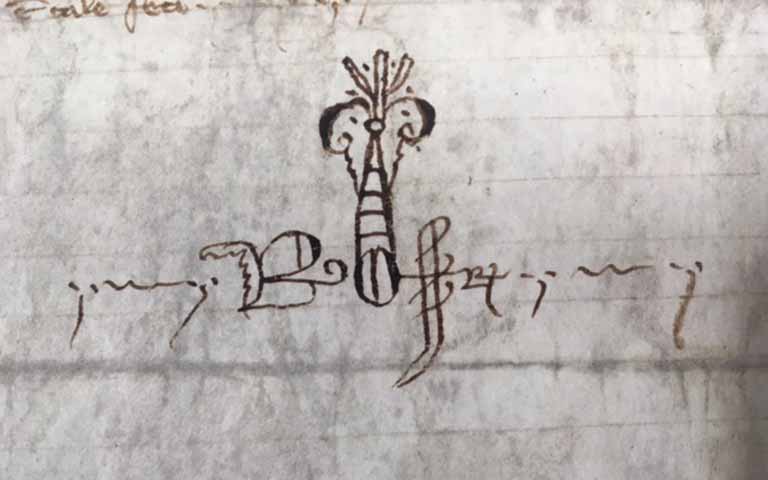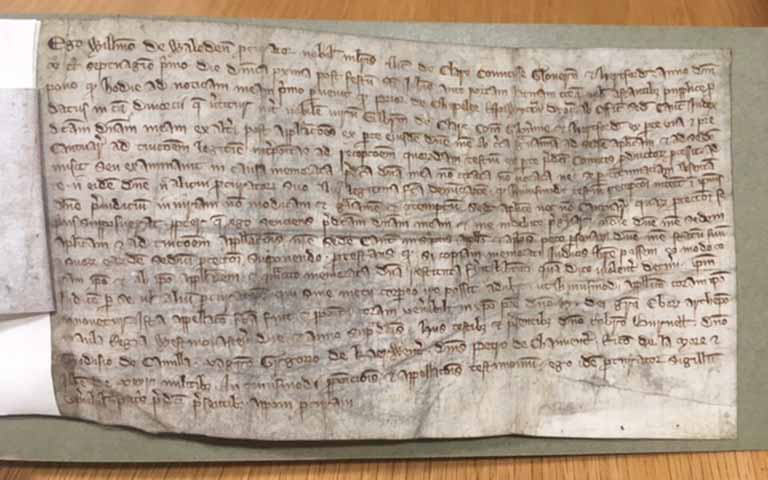In the middle ages, Church courts dealt with all religious matters including marriage, divorce and the punishment of adultery. Even after the Reformation, Church jurisdiction over marriage disputes continued until 1857.[ref]1. R. H. Helmholz, Marriage Litigation in Medieval England (Cambridge, 1974), 1-2[/ref] Within the E135 series, which I have been cataloguing as part of my PhD placement, is a discrete selection of documents dealing with these issues.
Divorce in the modern sense of the word did not exist in the medieval world.[ref]2. Ibid., 74[/ref] Although the term is used throughout the records in E135, what it actually meant here was an annulment which declared the marriage invalid.[ref]3.Ibid.[/ref] There were actually only a very small number of divorce cases in medieval England from the second half of the 13th century to the mid-16th century, which makes the documents relating to this in the E135 series so interesting.
Under medieval Church law, there were only a few, very specific reasons which could allow men and women to ask for a divorce. These included:
- where one party had a pre-contract of marriage with another individual
- there was a blood or spiritual relation between the individuals, for example a godparent
- impotence
- the use of force or fear to obtain consent
- the carrying out of a crime (usually adultery)
- marrying a minor
- clandestine marriages
- marriages entered into under false pretences[ref]4. For more details see Charles Donahue, Law, Marriage, and Society in the Later Middle Ages (Cambridge, 2007), 19-33[/ref]
In many of these cases, it was the lack of sufficient evidence which made them difficult to prove and this may have deterred people from taking their cases to the Church courts. Money was also an obstacle. Marital disputes among the nobility are the most well documented, as they had the means to pursue this expensive course of action. Occasionally we get a glimpse into the potential costs involved in a suit of divorce. For example, in 1531 the divorce between Elizabeth and Henry Savill accrued fees of £20 (E135/7/26). In today’s money, this would amount to about £7,000. This meant that often those from humbler backgrounds settled disputes amongst themselves by choosing to live apart.[ref]5. Helmholz, Marriage Litigation, 75[/ref]

Appeal made by Alice against her husband for the divorce (catalogue reference:
The earliest case which survives in the E135 series is the divorce for Gilbert de Clare (1243-95), known as Gilbert the Red, seventh earl of Gloucester and sixth earl of Hereford, and Alice de Clare (formally Alice de la Marche).
By 1267 Alice had become estranged from her husband and in 1271 she made an appeal for divorce.
Although the exact reason for this estrangement was not specified, it was rumoured that Edward I had an amorous interest in Alice, possibly suggesting the two of them had an affair. This may have contributed to the couple’s formal separation in 1271 and certainly deepened mistrust between the king and Gilbert.[ref]6. Clive H. Knowles, ‘Clare, Gilbert de, seventh earl of Gloucester and sixth earl of Hertford (1243–1295)’, Oxford Dictionary of National Biography, Oxford University Press, 2004 http://www.oxforddnb.com/view/article/5438, accessed 28 Nov 2016 [/ref]
There are two documents concerning this case within the series and William de Waldern, a clerk at the court, was the notary for both.

William de Waldern’s notarial symbol (catalogue reference: E125/7/1)
The first document (E135/7/1) is the appeal made by Alice against her husband for the divorce, and the second document, produced later in 1271 (E135/7/2) is another appeal made on Alice’s behalf to the court, as it appears that she has not been kept informed of her case’s progress.

Another appeal made on Alice’s behalf, 1271 (catalogue reference: E135/7/2)
The case was not fully resolved until over a decade later when in 1285 a divorce was finally granted. Gilbert was then given permission by the pope to marry Princess Joan of Acre, Edward I’s second surviving daughter, in 1290. Despite his formal separation from his first wife, Gilbert made provisions for Alice following their divorce in light of her noble heritage. However, he disinherited the two daughters he had with her in order to secure his royal marriage to Joan.[ref]7. Ibid[/ref]
The E135 series has provided me with a fascinating project, the variety of documents, themes and historical periods makes this series an exciting series to explore. Start your search to see what you might find.
[…] Even after the Reformation, Church jurisdiction over marriage disputes continued until 1857. 1 Within the E135 series, which I have been cataloguing as part of my PhD placement, is a discrete […]
I read a novel, supposedly based on a real case of the 1300’s: ‘The Knight & the Rose’, by Isolde Martyn – can you identify the case?
I would be interested to find out whether there are any records referring to a divorce between Edusa, daughter of Thomas of Hothersall, and Adam of Dutton (Lancs) in the late 12th century. Although VCH Lancs, vol. 7, gives her status as a widow, a case in the civil pleas of Lancs in 1292 (which I’m currently indexing) clearly refers to there being a divorce between the two. (AAALT 0018-0019 on the University of Houston website), JUST 1/416, m. 8. It would be nice to cite a TNA reference!
[personal details removed]
Hi Carrie,
Thanks for your comment.
We can’t answer research requests on the blog, but if you go to our ‘contact us’ page at http://nationalarchives.gov.uk/contact/ you’ll see how to get in touch with our record experts by email, live chat or phone.
Best regards,
Liz.
One of my early direct ancestors divorced her husband pre1624 (they had no children) and some years later remarried. This marriage produced children. I would love to know how many English women divorced their husbands at this time and what it would have cost?
Hi Debbie,
Thanks for your comment.
We can’t answer research requests on the blog, but if you go to our ‘contact us’ page at http://nationalarchives.gov.uk/contact/ you’ll see how to get in touch with our record experts by email, live chat or phone.
Best of luck with your research.
Kind regards,
Liz.
Gilbert The Red was one of my ancestors. Not surprised our family had a ‘first’ in this category, one of so many – firsts and divorces. As a historical fiction writer pivoting my plots and characters on my ancestors, this is an incredible find while I am pursing the background checks on my medieval family. Thank you for publishing this finding. I would never have thought to look in these archives until I tripped on this website. Way to go Granddad, glad you got remarried to Joan so I could exist. Your favourite great-xx-grand-daughter Susan.